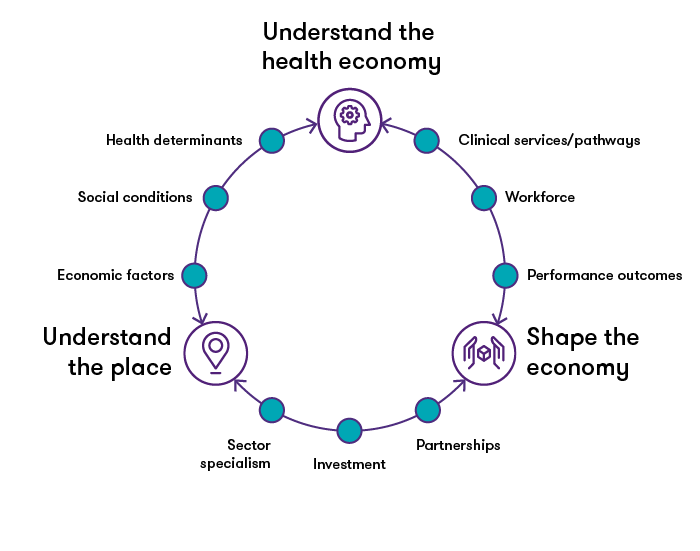Can hospitals drive economic change in a local area?

Can hospitals lead the growth and regeneration of a local area? Rob Turner, Director at Grant Thornton, examines how a hospital can act as a catalyst for economic change.
How do we create economic growth that benefits all parts of society? How do we best narrow the gap between the wealthiest and poorest parts of the country? How do we ensure that growth contributes positively to sustainability, health and wellbeing?
These questions, and others like them, sit at the heart of current policies around economic growth. But they are also questions for the health service.
Health systems have always been an important part of place, but imagine if NHS Trusts were recognised as one of the primary economic drivers in an area. This would mean that they took responsibility, alongside the local authority, for regeneration and economic growth and created clear linkages between the activities of the health economy and the community. This would help to address deep-set, socio-economic challenges from health determinants to barriers to employment
Put simply, investment in healthcare provision can act as a catalyst for change, like we have seen with Novo Nordisk in Oxford or AstraZeneca and GSK in Cambridge.
This integrated role between service provision and local places is one that hospitals, mental health hubs and primary care facilities are starting to play, particularly where there are new capital projects or service redesign programmes planned.
There are three ways in which we are seeing health play this role, both in the UK and internationally.
Acting as an anchor institution
As one of the largest employers in any locality, hospitals have an important role to play in underpinning the economies in which they are based. However, their roles as anchor institutions requires planning and design.
This has worked well in areas such as Singapore, Denmark and parts of the United States (for example, Boston and California) or in Cambridge and West Middlesex in the UK. Action in these areas has been around training, apprenticeships and engagement with education providers to ensure that local residents are better able to access employment opportunities.
Alongside this, there is a need to create strong local supply chains, so that the social value of procurement is increased as local businesses and social enterprises access opportunities. Or in the case of new capital schemes, it is using the development to engage partners and catalyse a wider programme of regeneration that includes both housing provision and new transport infrastructure.
Accelerating economic development
By their very nature, hospitals provide a hub for research and development. A redesigned or new hospital offers an opportunity to ensure that this hub is one that can sit at the heart of the local or sub-regional economic development strategy, as it helps to curate and build relationships with academia and the private sector.
As these relationships stimulate new ideas that are translated into new products and services, they can improve productivity, creating research and professional specialisms and clusters and provide access to sustainable funding streams. This will attract higher skilled and better-quality workers and, ultimately, draw fresh inward investment.
Where successful, it is an ecosystem that further embeds the hospital as a local anchor institution and, in turn, helps create economic opportunities that can reduce many of the determinants of poor health and associated inequalities.
For some places, this will see a focus on health and life sciences, but for others, the focus may be on the manufacture of devices and equipment, or logistics and supply chain management. The challenge is to ensure that there is alignment to the wider economy to ensure that what is planned builds directly on specific place-based assets and opportunities.

Reducing inequalities
A new or redesigned hospital provides opportunities to think very differently about the integration and engagement between different health services, as well as the links and integration with wider community-centred and civic-level interventions.
If we plan for a place, we could finally see proper integration of mental and physical health facilities and overall improved co-ordination between local services. These services should use data to support overall population health planning and identify susceptibility to long-term conditions.
In doing this we must focus on the social inequalities most prevalent in the local population that advances in technology and connectivity do not just improve outcomes for certain demographics.
Together, these factors will not only create more sustainable services, but provide an important catalyst to address often long-standing health inequalities. By thinking more broadly about the place, as opposed to just the site, there is a real opportunity for health to act as a positive driver of regeneration.
These changes will not happen automatically, however. They require intentionality and demand a detailed understanding of place and the health economy, so that the strengths, challenges, issues and opportunities of a place are not only well understood, but these factors are translated in to a clear, well-articulated strategic case for change that can shape the local economy.
It is vital that this framework and associated narrative is one that is understood, not just by those in the health system, but across local government, education and the private sector.
Placing health services at the centre of place economy also necessitates a change in culture and practice, particularly if central government investment is to be prioritised to the particular scheme in question. This requires the economic case for change to look beyond the traditional ‘intrinsic’ benefits that arise through clinical model innovations, redesigned healthcare services, the colocation of services and the leveraging of technology, important though these are.
The economic case needs to also carefully identify and quantify the external sphere of influence and the benefits associated with an ‘anchor’ hospital in terms of wider public health improvements, the contribution to addressing the wider determinants of health and the wider economic development and regeneration role that the hospital can play.
If there is a strong understanding of the benefits, then individual organisational behaviours will change and the key questions will start to be answered.
To understand more about the positive role that the health estate and economy can play in your place, get in touch with Rob Turner, or for support in making the case contact Malcolm Lowe-Lauri or Matt Custance.
